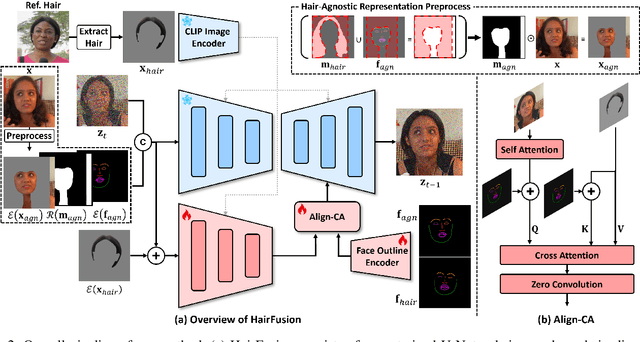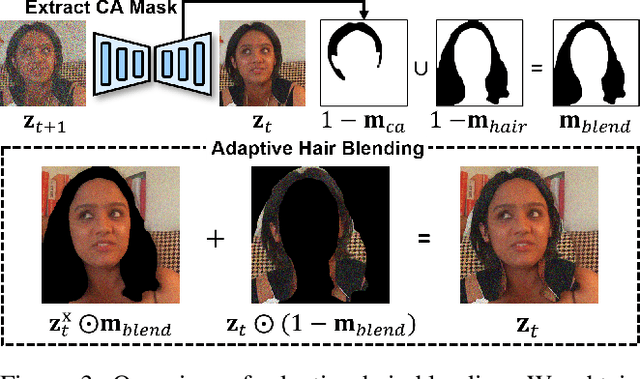Jeongho Kim
MultiHuman-Testbench: Benchmarking Image Generation for Multiple Humans
Jun 25, 2025Abstract:Generation of images containing multiple humans, performing complex actions, while preserving their facial identities, is a significant challenge. A major factor contributing to this is the lack of a a dedicated benchmark. To address this, we introduce MultiHuman-Testbench, a novel benchmark for rigorously evaluating generative models for multi-human generation. The benchmark comprises 1800 samples, including carefully curated text prompts, describing a range of simple to complex human actions. These prompts are matched with a total of 5,550 unique human face images, sampled uniformly to ensure diversity across age, ethnic background, and gender. Alongside captions, we provide human-selected pose conditioning images which accurately match the prompt. We propose a multi-faceted evaluation suite employing four key metrics to quantify face count, ID similarity, prompt alignment, and action detection. We conduct a thorough evaluation of a diverse set of models, including zero-shot approaches and training-based methods, with and without regional priors. We also propose novel techniques to incorporate image and region isolation using human segmentation and Hungarian matching, significantly improving ID similarity. Our proposed benchmark and key findings provide valuable insights and a standardized tool for advancing research in multi-human image generation.
ReCDAP: Relation-Based Conditional Diffusion with Attention Pooling for Few-Shot Knowledge Graph Completion
May 12, 2025Abstract:Knowledge Graphs (KGs), composed of triples in the form of (head, relation, tail) and consisting of entities and relations, play a key role in information retrieval systems such as question answering, entity search, and recommendation. In real-world KGs, although many entities exist, the relations exhibit a long-tail distribution, which can hinder information retrieval performance. Previous few-shot knowledge graph completion studies focused exclusively on the positive triple information that exists in the graph or, when negative triples were incorporated, used them merely as a signal to indicate incorrect triples. To overcome this limitation, we propose Relation-Based Conditional Diffusion with Attention Pooling (ReCDAP). First, negative triples are generated by randomly replacing the tail entity in the support set. By conditionally incorporating positive information in the KG and non-existent negative information into the diffusion process, the model separately estimates the latent distributions for positive and negative relations. Moreover, including an attention pooler enables the model to leverage the differences between positive and negative cases explicitly. Experiments on two widely used datasets demonstrate that our method outperforms existing approaches, achieving state-of-the-art performance. The code is available at https://github.com/hou27/ReCDAP-FKGC.
* Accepted by SIGIR 2025, 5 pages, 1 figure
PromptDresser: Improving the Quality and Controllability of Virtual Try-On via Generative Textual Prompt and Prompt-aware Mask
Dec 22, 2024Abstract:Recent virtual try-on approaches have advanced by fine-tuning the pre-trained text-to-image diffusion models to leverage their powerful generative ability. However, the use of text prompts in virtual try-on is still underexplored. This paper tackles a text-editable virtual try-on task that changes the clothing item based on the provided clothing image while editing the wearing style (e.g., tucking style, fit) according to the text descriptions. In the text-editable virtual try-on, three key aspects exist: (i) designing rich text descriptions for paired person-clothing data to train the model, (ii) addressing the conflicts where textual information of the existing person's clothing interferes the generation of the new clothing, and (iii) adaptively adjust the inpainting mask aligned with the text descriptions, ensuring proper editing areas while preserving the original person's appearance irrelevant to the new clothing. To address these aspects, we propose PromptDresser, a text-editable virtual try-on model that leverages large multimodal model (LMM) assistance to enable high-quality and versatile manipulation based on generative text prompts. Our approach utilizes LMMs via in-context learning to generate detailed text descriptions for person and clothing images independently, including pose details and editing attributes using minimal human cost. Moreover, to ensure the editing areas, we adjust the inpainting mask depending on the text prompts adaptively. We found that our approach, utilizing detailed text prompts, not only enhances text editability but also effectively conveys clothing details that are difficult to capture through images alone, thereby enhancing image quality. Our code is available at https://github.com/rlawjdghek/PromptDresser.
What to Preserve and What to Transfer: Faithful, Identity-Preserving Diffusion-based Hairstyle Transfer
Aug 29, 2024



Abstract:Hairstyle transfer is a challenging task in the image editing field that modifies the hairstyle of a given face image while preserving its other appearance and background features. The existing hairstyle transfer approaches heavily rely on StyleGAN, which is pre-trained on cropped and aligned face images. Hence, they struggle to generalize under challenging conditions such as extreme variations of head poses or focal lengths. To address this issue, we propose a one-stage hairstyle transfer diffusion model, HairFusion, that applies to real-world scenarios. Specifically, we carefully design a hair-agnostic representation as the input of the model, where the original hair information is thoroughly eliminated. Next, we introduce a hair align cross-attention (Align-CA) to accurately align the reference hairstyle with the face image while considering the difference in their face shape. To enhance the preservation of the face image's original features, we leverage adaptive hair blending during the inference, where the output's hair regions are estimated by the cross-attention map in Align-CA and blended with non-hair areas of the face image. Our experimental results show that our method achieves state-of-the-art performance compared to the existing methods in preserving the integrity of both the transferred hairstyle and the surrounding features. The codes are available at https://github.com/cychungg/HairFusion.
TCAN: Animating Human Images with Temporally Consistent Pose Guidance using Diffusion Models
Jul 12, 2024



Abstract:Pose-driven human-image animation diffusion models have shown remarkable capabilities in realistic human video synthesis. Despite the promising results achieved by previous approaches, challenges persist in achieving temporally consistent animation and ensuring robustness with off-the-shelf pose detectors. In this paper, we present TCAN, a pose-driven human image animation method that is robust to erroneous poses and consistent over time. In contrast to previous methods, we utilize the pre-trained ControlNet without fine-tuning to leverage its extensive pre-acquired knowledge from numerous pose-image-caption pairs. To keep the ControlNet frozen, we adapt LoRA to the UNet layers, enabling the network to align the latent space between the pose and appearance features. Additionally, by introducing an additional temporal layer to the ControlNet, we enhance robustness against outliers of the pose detector. Through the analysis of attention maps over the temporal axis, we also designed a novel temperature map leveraging pose information, allowing for a more static background. Extensive experiments demonstrate that the proposed method can achieve promising results in video synthesis tasks encompassing various poses, like chibi. Project Page: https://eccv2024tcan.github.io/
StableVITON: Learning Semantic Correspondence with Latent Diffusion Model for Virtual Try-On
Dec 04, 2023



Abstract:Given a clothing image and a person image, an image-based virtual try-on aims to generate a customized image that appears natural and accurately reflects the characteristics of the clothing image. In this work, we aim to expand the applicability of the pre-trained diffusion model so that it can be utilized independently for the virtual try-on task.The main challenge is to preserve the clothing details while effectively utilizing the robust generative capability of the pre-trained model. In order to tackle these issues, we propose StableVITON, learning the semantic correspondence between the clothing and the human body within the latent space of the pre-trained diffusion model in an end-to-end manner. Our proposed zero cross-attention blocks not only preserve the clothing details by learning the semantic correspondence but also generate high-fidelity images by utilizing the inherent knowledge of the pre-trained model in the warping process. Through our proposed novel attention total variation loss and applying augmentation, we achieve the sharp attention map, resulting in a more precise representation of clothing details. StableVITON outperforms the baselines in qualitative and quantitative evaluation, showing promising quality in arbitrary person images. Our code is available at https://github.com/rlawjdghek/StableVITON.
Hamilton-Jacobi Deep Q-Learning for Deterministic Continuous-Time Systems with Lipschitz Continuous Controls
Oct 27, 2020



Abstract:In this paper, we propose Q-learning algorithms for continuous-time deterministic optimal control problems with Lipschitz continuous controls. Our method is based on a new class of Hamilton-Jacobi-Bellman (HJB) equations derived from applying the dynamic programming principle to continuous-time Q-functions. A novel semi-discrete version of the HJB equation is proposed to design a Q-learning algorithm that uses data collected in discrete time without discretizing or approximating the system dynamics. We identify the condition under which the Q-function estimated by this algorithm converges to the optimal Q-function. For practical implementation, we propose the Hamilton-Jacobi DQN, which extends the idea of deep Q-networks (DQN) to our continuous control setting. This approach does not require actor networks or numerical solutions to optimization problems for greedy actions since the HJB equation provides a simple characterization of optimal controls via ordinary differential equations. We empirically demonstrate the performance of our method through benchmark tasks and high-dimensional linear-quadratic problems.
Hamilton-Jacobi-Bellman Equations for Q-Learning in Continuous Time
Dec 23, 2019


Abstract:In this paper, we introduce Hamilton-Jacobi-Bellman (HJB) equations for Q-functions in continuous time optimal control problems with Lipschitz continuous controls. The standard Q-function used in reinforcement learning is shown to be the unique viscosity solution of the HJB equation. A necessary and sufficient condition for optimality is provided using the viscosity solution framework. By using the HJB equation, we develop a Q-learning method for continuous-time dynamical systems. A DQN-like algorithm is also proposed for high-dimensional state and control spaces. The performance of the proposed Q-learning algorithm is demonstrated using 1-, 10- and 20-dimensional dynamical systems.
 Add to Chrome
Add to Chrome Add to Firefox
Add to Firefox Add to Edge
Add to Edge